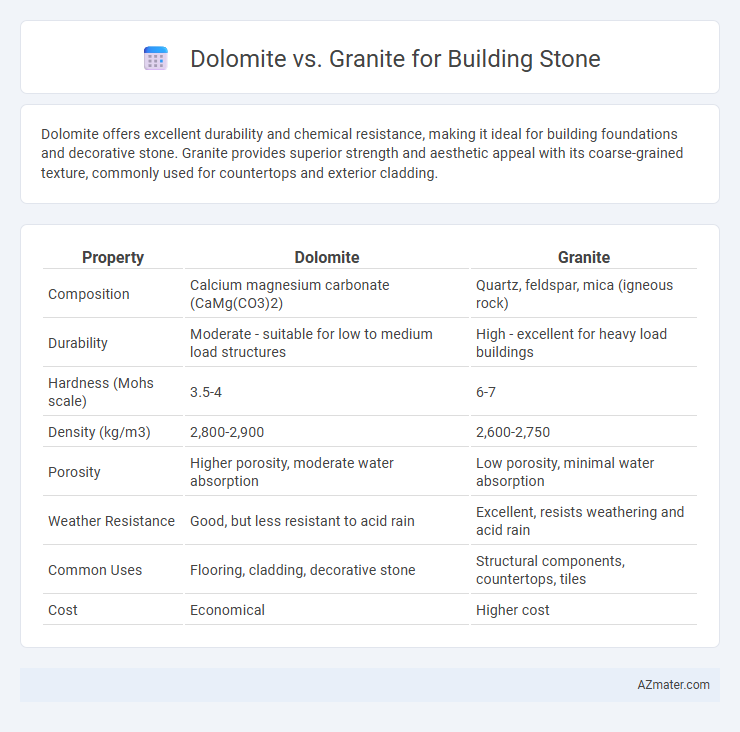Dolomite offers excellent durability and chemical resistance, making it ideal for building foundations and decorative stone. Granite provides superior strength and aesthetic appeal with its coarse-grained texture, commonly used for countertops and exterior cladding.
Table of Comparison
| Property | Dolomite | Granite |
|---|---|---|
| Composition | Calcium magnesium carbonate (CaMg(CO3)2) | Quartz, feldspar, mica (igneous rock) |
| Durability | Moderate - suitable for low to medium load structures | High - excellent for heavy load buildings |
| Hardness (Mohs scale) | 3.5-4 | 6-7 |
| Density (kg/m3) | 2,800-2,900 | 2,600-2,750 |
| Porosity | Higher porosity, moderate water absorption | Low porosity, minimal water absorption |
| Weather Resistance | Good, but less resistant to acid rain | Excellent, resists weathering and acid rain |
| Common Uses | Flooring, cladding, decorative stone | Structural components, countertops, tiles |
| Cost | Economical | Higher cost |
Introduction to Dolomite and Granite as Building Stones
Dolomite and granite serve distinct roles in construction due to their unique mineral compositions and physical properties. Dolomite, primarily composed of calcium magnesium carbonate, offers excellent durability and resistance to weathering, making it suitable for facades and flooring. Granite, composed mainly of quartz and feldspar, is prized for its hardness, diverse color range, and resistance to abrasion, providing structural strength and aesthetic appeal in building projects.
Geological Formation and Composition
Dolomite is a sedimentary carbonate rock primarily composed of the mineral dolomite (CaMg(CO3)2), formed through the diagenetic alteration of limestone by magnesium-rich fluids during shallow marine environments. Granite is an intrusive igneous rock consisting mainly of quartz, feldspar, and mica, crystallizing slowly from magma beneath the Earth's crust, resulting in a coarse-grained texture. The contrasting geological formations influence their durability and appearance, with dolomite exhibiting greater chemical resistance due to its carbonate composition, while granite offers superior strength and hardness from its crystalline silicate minerals.
Physical Properties Comparison
Dolomite exhibits higher hardness, typically around 3.5 to 4 on the Mohs scale, compared to granite's range of 6 to 7, making granite significantly more abrasion-resistant. Granite's crystalline structure provides superior compressive strength, often exceeding 130 MPa, whereas dolomite generally registers between 90 to 120 MPa. Porosity levels in dolomite are slightly higher, averaging 0.3-2%, which affects its durability and water absorption when contrasted with granite's lower porosity, typically under 0.5%.
Durability and Strength Analysis
Dolomite exhibits superior compressive strength and increased resistance to weathering compared to granite, making it highly durable for building stone applications. Granite, known for its coarse grain and interlocking crystal structure, offers excellent tensile strength and abrasion resistance suitable for structural uses. Both stones provide robust durability; however, dolomite's higher density and chemical stability often result in enhanced long-term performance in harsh environmental conditions.
Aesthetic Appeal and Color Variations
Dolomite offers a classic, granular texture with subtle earth tones, providing a softer, more natural aesthetic ideal for traditional building designs. Granite features a wide spectrum of colors from pinks to blacks with striking speckled patterns, delivering a bold, durable appearance favored in contemporary architecture. Both stones enhance visual appeal through distinct color variations, but granite's vibrant palette and polished finish often create a more dramatic impact.
Cost and Availability Factors
Dolomite typically costs less than granite due to its wider availability and easier quarrying processes, making it a budget-friendly option for large construction projects. Granite, known for its durability and aesthetic appeal, often comes at a higher price because of limited quarry locations and more complex extraction methods. Availability of dolomite is generally greater in regions with sedimentary rock formations, whereas granite is more common in areas with significant igneous rock deposits, influencing local pricing and supply.
Workability and Installation Differences
Dolomite offers improved workability over granite due to its finer grain structure, making it easier to cut, shape, and drill during installation. Granite's hardness and density contribute to longer installation times and require specialized tools, whereas dolomite allows for faster handling and reduced labor costs. The difference in workability significantly impacts project timelines and budget when choosing between these two durable building stones.
Weather Resistance and Maintenance Requirements
Dolomite exhibits excellent weather resistance due to its dense crystalline structure, making it highly durable against freeze-thaw cycles and acid rain, often outperforming granite in harsh environmental conditions. Granite, while extremely hard and resistant to abrasion, can be more susceptible to chemical weathering and requires periodic sealing to maintain its appearance and structural integrity. Maintenance of dolomite is generally lower, as it resists staining and erosion better than granite, which often demands more frequent cleaning and protective treatments to prevent surface degradation.
Environmental Impact and Sustainability
Dolomite typically exhibits lower environmental impact during quarrying due to its abundant availability and less intensive processing requirements compared to granite, which demands more energy-intensive extraction and cutting techniques. Granite's durability and longevity contribute to sustainability by reducing the need for frequent replacements, whereas dolomite's slightly lower hardness may lead to quicker wear in high-traffic applications. Lifecycle assessments indicate granite's higher embodied energy, but dolomite's faster regeneration in natural deposits supports more sustainable sourcing practices for environmentally conscious construction projects.
Applications in Modern Construction
Dolomite, known for its high durability and resistance to weathering, is frequently used in road base materials, concrete aggregates, and dimension stone in modern construction projects. Granite, prized for its exceptional hardness and aesthetic appeal, serves extensively in countertops, flooring, and exterior cladding, providing both structural soundness and visual elegance. The choice between dolomite and granite depends on specific project requirements, balancing factors like load-bearing capacity, environmental exposure, and desired finishes.

Infographic: Dolomite vs Granite for Building Stone
 azmater.com
azmater.com